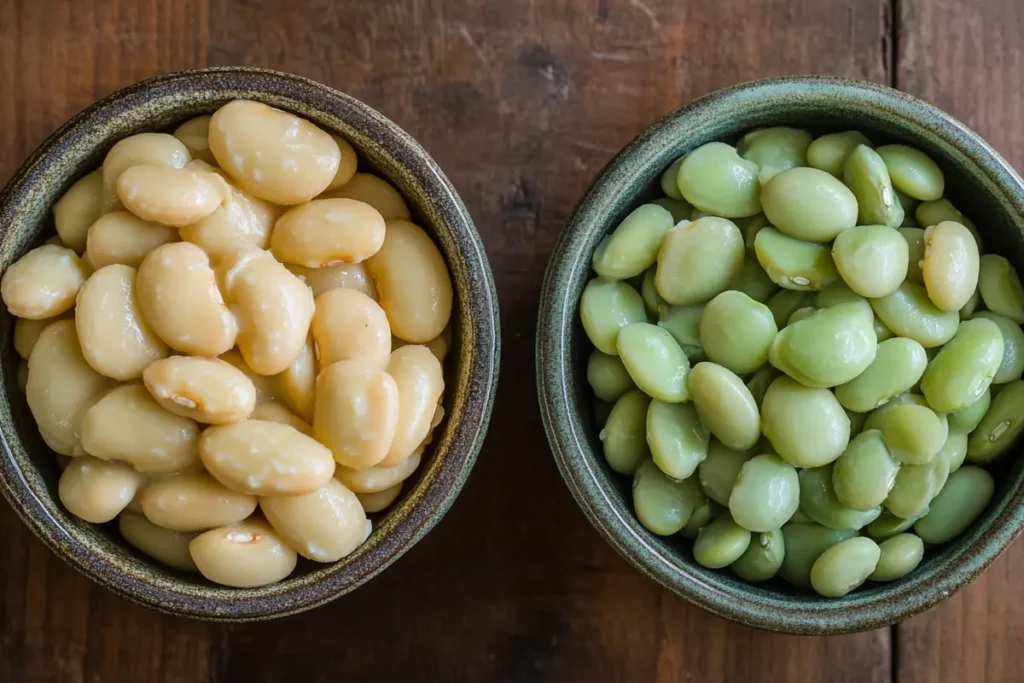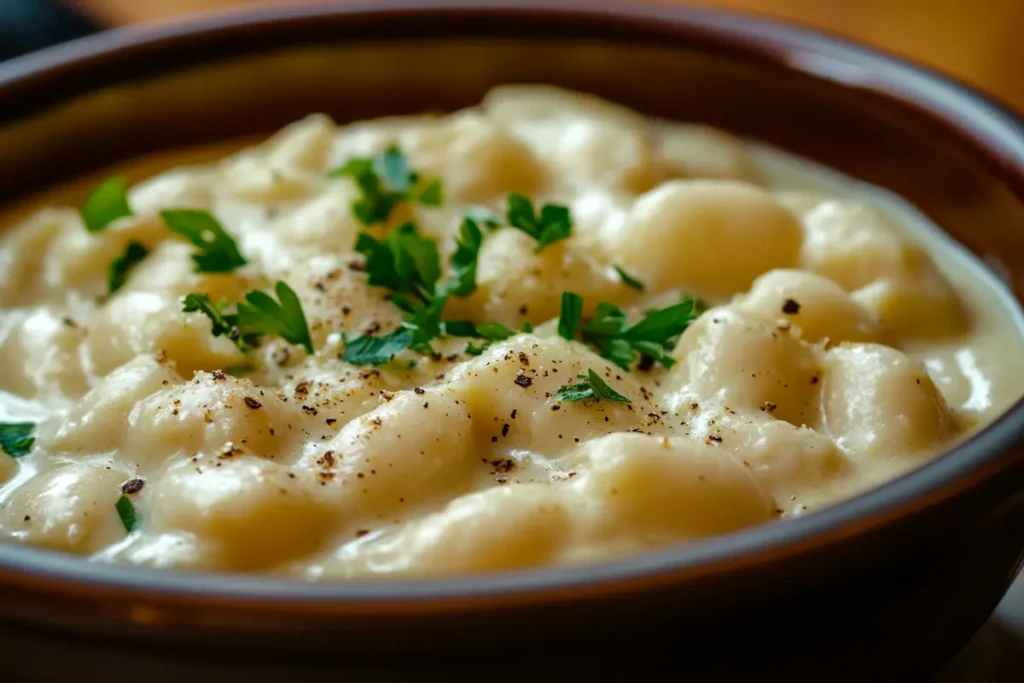Are butter beans and lima beans the same? This is a common question among food lovers, chefs, and home cooks. While many use the terms interchangeably, there are subtle differences in how they are named, cooked, and enjoyed in various cuisines.
What Are Butter Beans and Lima Beans?
What Are Butter Beans?
Butter beans, often recognized for their creamy texture and light flavor, are a type of legume adored in Southern U.S. cuisine. They are larger, flatter, and boast a pale yellow or off-white hue when mature. Known for their “melt-in-your-mouth” quality when cooked, butter beans are typically used in hearty stews, casseroles, and side dishes. Their smooth texture and buttery taste make them a staple in comforting recipes.
Although often associated with the Southern U.S., butter beans are enjoyed worldwide. Whether dried, canned, or fresh, they add richness and depth to dishes, making them a favorite choice for cooks seeking a versatile ingredient.
What Are Lima Beans?
Lima beans, the more widely recognized name for this legume, originate from Peru and are named after the country’s capital, Lima. These beans come in various sizes, such as baby lima beans and large Fordhook varieties. Typically green when fresh, lima beans turn creamy or beige as they mature and dry.
Lima beans are celebrated for their earthy taste and slight nutty undertones. They’re a favorite in vegetarian meals, thanks to their high protein and fiber content. From soups to salads, lima beans bring a hearty yet wholesome touch to the plate.
The History of Butter Beans and Lima Beans
Did you know that lima beans have been cultivated for over 7,000 years? Their history dates back to ancient Peru, where they were a dietary staple of indigenous people. The name “butter beans” later emerged in the Southern U.S. as a regional nickname. While the term “lima bean” reflects the bean’s origins, “butter bean” speaks to its creamy texture and flavor.
In Europe and the Americas, these beans took on various names depending on their size and how they were cooked. However, their global popularity remains undeniable, making them a nutritious addition to countless cuisines.
Key Differences
Are Butter Beans and Lima Beans Really Different?
At first glance, butter beans and lima beans may seem like entirely different legumes, but they are essentially two names for the same bean species. However, the distinction often comes down to regional preferences and how these beans are prepared or perceived.
In the Southern U.S., butter beans are a household favorite. This term usually refers to the larger, cream-colored variety of lima beans, known for their buttery texture when cooked. In contrast, outside the U.S. and in many global regions, the term “lima beans” is used to encompass all varieties, including both baby and large-sized beans.
Regional cooking styles also influence how these beans are labeled. Southern recipes often cook butter beans with rich, savory ingredients like smoked turkey or flavorful herbs, while “lima beans” in international cuisines may be associated with lighter, plant-forward dishes. This regional divide explains why these two names are often used interchangeably, even though they refer to the same plant species.
Nutritional Comparison
From a nutritional perspective, butter beans and lima beans offer similar health benefits, as they come from the same species. However, slight differences in preparation and size can lead to variations in nutrient density.
| Nutrient | Butter Beans (1 cup, cooked) | Lima Beans (1 cup, cooked) |
|---|---|---|
| Calories | 200 | 220 |
| Protein | 14g | 13g |
| Fiber | 13g | 9g |
| Carbohydrates | 37g | 39g |
| Fat | 1g | 0.7g |
Butter beans tend to have slightly more protein and fiber, making them a great option for those focusing on muscle building or digestive health. Meanwhile, lima beans are often slightly higher in carbohydrates, providing energy-boosting nutrients. Both are rich in iron, potassium, and magnesium, contributing to overall health benefits like better blood circulation and muscle function.
In terms of health benefits, both beans support heart health, help regulate blood sugar levels, and are excellent sources of plant-based protein for vegetarians and vegans. Whether you choose butter beans or lima beans, you can count on a nutrient-dense addition to your diet.
Varieties and Sizes of Lima Beans
- Baby Lima Beans: These smaller beans are tender and sweeter in flavor, making them ideal for salads, light soups, and quick side dishes. Their small size allows for faster cooking.
- Large Lima Beans (Fordhook Lima Beans): These are larger, creamier, and richer in flavor. When cooked, they develop the signature buttery texture often associated with butter beans.
It’s important to note that butter beans are not a separate species but rather a specific variety of lima beans, often referring to the mature, larger Fordhook type. Baby lima beans and butter beans come from the same plant but differ in how they’re harvested and prepared.
Culinary Uses and Regional Preferences
How Butter Beans Are Used in Cooking
- Stews and Soups: Butter beans add body and creaminess to dishes like vegetable stews, chicken and butter bean soups, and hearty winter broths.
- Casseroles: Their ability to absorb flavors makes butter beans a go-to ingredient in casseroles. They complement savory sauces and rich seasonings effortlessly.
- Salads: When chilled and tossed with fresh vegetables, herbs, and a vinaigrette, butter beans transform into a refreshing, protein-packed salad ingredient.
- Dips and Spreads: Blended with olive oil, garlic, and lemon juice, butter beans create a smooth and flavorful dip similar to hummus.
How Lima Beans Are Used in Cooking
- Soups and Broths: Baby lima beans are often added to lighter soups, where their tender texture complements other vegetables.
- Side Dishes: Simply boiled or sautéed with garlic, lima beans shine as a nutritious side dish.
- Rice and Grain Bowls: Lima beans add texture and protein to rice pilafs or grain-based dishes.
- Purees: Cooked lima beans can be pureed into creamy bases for sauces or baby food.
Butter Beans in Southern Cuisine
Butter beans hold a special place in traditional Southern U.S. cuisine. Their creamy consistency and ability to absorb seasonings make them the perfect match for slow-cooked dishes. In Southern kitchens, butter beans are often cooked with smoked turkey to infuse them with savory, smoky flavors.
They’re frequently served as a side dish, seasoned with salt, pepper, and butter, or incorporated into casseroles alongside cornbread and greens. The name “butter beans” became popular in the South due to their buttery texture and flavor, which stood out in regional dishes.
Substituting Butter Beans and Lima Beans in Recipes
Thanks to their similarities, butter beans and lima beans can often be used interchangeably in recipes. For instance, you can swap lima beans for butter beans in stews or casseroles if you prefer smaller beans or a slightly firmer texture. Likewise, butter beans can replace lima beans in dishes where a creamy finish is desired, such as purees or hearty soups.
However, it’s important to consider texture and size. Baby lima beans are ideal for lighter dishes like salads or stir-fries, while butter beans work best in slow-cooked or rich recipes.
If neither is available, alternative beans like cannellini beans or navy beans can be excellent substitutes. While they lack the characteristic creaminess of butter beans, they still provide a mild flavor and soft texture that works well in most recipes.
Nutritional and Health Benefits
Health Benefits of Butter Beans
Butter beans are a powerhouse of nutrition, offering a well-rounded combination of protein, fiber, and essential vitamins that can boost overall health. Their high protein content makes them a staple for those on plant-based diets or anyone looking to incorporate more sustainable protein sources. With about 14 grams of protein per cooked cup, butter beans contribute significantly to muscle maintenance and repair.
Additionally, butter beans are packed with dietary fiber, which aids in digestion and helps maintain healthy gut bacteria. A single cup provides nearly 50% of the recommended daily intake of fiber, which can reduce bloating, support regular bowel movements, and even lower cholesterol levels.
Butter beans are also a rich source of heart-healthy nutrients like potassium and magnesium, which help regulate blood pressure and improve cardiovascular health. Their low-fat and cholesterol-free profile further enhances their benefits for heart health. Moreover, their slow-digesting carbohydrates make them an excellent option for weight management, as they promote satiety and prevent overeating.
Health Benefits of Lima Beans
Lima beans are nutritional gems that offer similar benefits to butter beans, with a few unique distinctions. They are abundant in essential minerals like iron, zinc, and folate, all of which play a key role in red blood cell production and energy metabolism. For individuals struggling with fatigue or anemia, lima beans can be a valuable addition to their diet.
These beans are also great for stabilizing blood sugar levels. Thanks to their low glycemic index, lima beans release glucose slowly into the bloodstream, helping prevent spikes in blood sugar levels. This makes them a fantastic option for individuals managing diabetes or insulin resistance.
Lima beans are naturally rich in antioxidants, which combat oxidative stress and inflammation. Additionally, they contain a good amount of manganese, which supports bone health and metabolism. For those seeking a versatile and nutritious ingredient, lima beans tick all the boxes.
Are Butter Beans or Lima Beans Healthier?
While butter beans and lima beans share most of their nutritional benefits, slight differences can cater to individual dietary needs. Butter beans tend to have slightly more fiber and protein, making them better suited for those focusing on digestive health or building muscle. On the other hand, lima beans contain more complex carbohydrates and specific minerals like folate and manganese, which are beneficial for sustained energy and bone strength.
Ultimately, the choice between butter beans and lima beans comes down to personal preference and dietary goals. Both are excellent sources of plant-based nutrition, so you can’t go wrong including either—or both!—in your meals. Incorporating them into your diet is a flavorful and wholesome way to support your health.
FAQs
Are butter beans and lima beans the same?
Yes, butter beans and lima beans are essentially the same bean, but the terminology differs depending on region and context. In the United States, particularly in the Southern states, the term butter beans is widely used to describe the larger, mature version of lima beans, which develop a creamy texture when cooked. Globally, however, “lima beans” is the more common name, referring to all varieties, including baby and large beans. Despite the different names, they come from the same plant species, Phaseolus lunatus.
What are butter beans called in the US?
In the United States, the term butter beans is used primarily in the South, where they are a culinary staple. In other parts of the country, they are simply referred to as lima beans, regardless of size. However, canned or frozen large lima beans are often labeled as butter beans, reinforcing the regional preference for the name. This difference in terminology can sometimes cause confusion, but both names are widely accepted.
Can you substitute butter beans for lima beans in recipes?
Absolutely! Butter beans and lima beans are interchangeable in most recipes due to their shared origin and similar flavor profiles. For instance, butter beans work beautifully in soups, stews, and casseroles where their creamy texture is highlighted. Similarly, baby lima beans can be used in lighter dishes like salads or stir-fries. The main consideration is size and texture—if your recipe calls for a delicate presentation, baby lima beans might be better, whereas butter beans shine in heartier dishes.
Are butter beans healthier than lima beans?
Nutritionally, both butter beans and lima beans are very similar, offering excellent sources of protein, fiber, and essential vitamins like potassium and folate. However, butter beans tend to have a slight edge in protein and fiber content, which may make them more suitable for individuals focusing on muscle building or digestive health. On the other hand, lima beans provide slightly more carbohydrates and folate, making them great for sustained energy and overall health. Both options are healthy and nutrient-dense, so the choice comes down to dietary preferences.
What are butter beans good for?
Butter beans are incredibly versatile and can be used in a variety of dishes. They are perfect for creating creamy soups, hearty casseroles, or even dips and spreads. Thanks to their high fiber and protein content, butter beans are excellent for supporting digestive health, maintaining steady blood sugar levels, and promoting heart health. Whether you’re looking for a comforting side dish or a plant-based protein source, butter beans are a fantastic choice.


